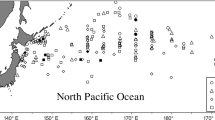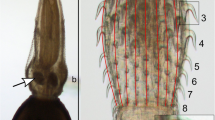Abstract
Plerocercoids of Diphyllobothrium dendriticum were isolated from whitefish (Coregonus clupeaformis) from McGregor Lake, Alberta. Adult D. dendriticum were obtained by infection of golden hamsters (Mesocricetus auratus). Analysis of morphological variables indicated high variability and some overlap with D. latum. Correlations in morphology were due to the covariance of shape variables. Isozyme analysis also showed high variability, with two thirds of the enzymes studied being polymorphic. Correlations with morphology indicate a relationship between rare patterns for malate dehydrogenase and esterase and increased size of adults. Southern hybridisation with ribosomal gene probes produced two common patterns and a rare intermediate form, indicating that the species is variable even within a local population. Correlations between rDNA pattern type and morphological variables supported the hypothesis of a genetic base for the morphological variability.
Similar content being viewed by others
References
Andersen, K. (1975) Studies of the helminth fauna of Norway XXXIV: The morphological stability of Diphyllobothrium Cobbold. A comparison of adult D. dendriticum (Nitzsch), D. latum (L.) and D. ditremum (Creplin) developed in different hosts. Norwegian Journal of Zoology, 23, 45–53.
Andersen, K., Ching, H.L. & Vik, R. (1987) A review of freshwater species of Diphyllobothrium with redescriptions and the distribution of D. dendriticum (Nitzsch, 1824) and D. ditremum (Creplin, 1825) from North America. Canadian Journal of Zoology, 65, 2216–2228.
Andersen, K. & Gibson, D.I. (1989) A key to three species of larval Diphyllobothrium Cobbold, 1958 (Cestoda: Pseudophyllidea) occurring in European and North American freshwater fishes. Systematic Parasitology, 13, 3–9.
Baverstock, P.R., Adams, M. & Beveridge, I. (1985) Biochemical differences in bile duct cestodes and their marsupial hosts. Molecular Biology and Evolution, 2, 321–337.
Bylund, G. & Djupsund, B.M. (1977) Protein profiles as an aid to taxonomy in the genus Diphyllobothrium. Zeitschrift für Parasitenkunde, 51, 241–247.
Davis, L.G., Dibner, M.D. & Battey, J.F. (1986) Methods in molecular biology, New York: Elsevier Science Publishing Co., 388 pp.
deVos, T. & Dick, T.A. (1989) Differentiation between Diphyllobothrium dendriticum and D. latum using isozymes, restriction profiles and ribosomal gene probes. Systematic Parasitology, 13, 161–166.
Dick, T.A. & Poole, B.C. (1985) Identification of Diphyllobothrium dendriticum and Diphyllobothrium latum from some freshwater fishes of central Canada. Canadian Journal of Zoology, 63, 196–201.
Files, J.G. & Hirsh, D. (1981) Ribosomal DNA of Caenorhabditis elegans. Journal of Molecular Biology, 149, 223–240.
Gerbi, S.A. (1986) The evolution of eukaryotic ribosomal DNA. Biosystems, 19, 247–258.
Harris, H. & Hopkinson, D.A. (1976) Handbook of enzyme electrophoresis in human genetics. Amsterdam: North Holland Publishing Co.
Maniatis, T., Fritsch, E.F. & Sambrook, J. (1982) Molecular cloning: a laboratory manual. Cold Spring Harbor, New York: Cold Spring Harbor Laboratory, 545 pp.
McManus, D.P. & Simpson, A.J.G. (1985) Identification of Echinococcus (hydatid disease) organisms using cloned DNA markers. Molecular and Biochemical Parasitology, 17, 171–178.
Nei, N. (1983) Genetic polymorphism and the role of mutation in evolution. In: Nei, M. & Koehn, R.K. (eds) Evolution of genes and proteins. Sunderland, Mass.: Sinauer Associates Inc. Publs, pp. 165–190.
Siddiqui, A.A., Karcz, S.R. & Podesta, R.B. (1987) Developmental and immune regulation of gene expression in Hymenolepis diminuta. Molecular and Biochemical Parasitology, 25, 19–28.
Schantz, P.M., Colli, C., Cruz-Reyes, A. & Prezioso, U. (1976) Sylvatic echinococcosis in Argentina. II. Susceptibility of wild carnivores to Echinococcus granulosus (Batsch, 1786) and host-induced morphological variation. Tropenmedizin und Parasitologie, 27, 70–78.
Smyth, J.D. & Smyth, M.M. (1964) Natural and experimental hosts of Echinococcus granulosus and E. multilocularis, with comments on the genetics of speciation in the genus Echinococcus. Parasitology, 54, 493–514.
Thompson, R.C.A. & Lymbery, A.J. (1988) The nature, extent and significance of variation within the genus Echinococcus. Advances in Parasitology, 27, 209–258.
Author information
Authors and Affiliations
Rights and permissions
About this article
Cite this article
de Vos, T., Szalai, A.J. & Dick, T.A. Genetic and morphological variability in a population of Diphyllobothrium dendriticum (Nitzsch, 1824). Syst Parasitol 16, 99–105 (1990). https://doi.org/10.1007/BF00009609
Accepted:
Issue Date:
DOI: https://doi.org/10.1007/BF00009609




